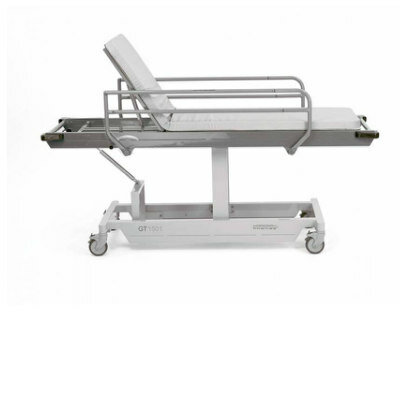Merger Expected to Accelerate Development of Personalized Medicine Solutions
|
By HospiMedica International staff writers Posted on 28 Dec 2014 |
Acquisition of an American company specializing in data management and analysis by a worldwide leader in genomics research and diagnostics development is expected to decrease the complexity, time, and cost of genomic analysis and accelerate development of the science of personalized medicine.
The biotech company Roche (Basel, Switzerland), an acknowledged leader in research-focused healthcare with combined strengths in pharmaceuticals and diagnostics, has announced the acquisition of the American company Bina Technologies, Inc. (Redwood City, CA, USA).
Bina’s integrated, scalable, and comprehensive analysis platform, Genomic Management Solution or Bina-GMS1, empowers clinical and academic researchers to gain insight from their genomics data sets by dramatically decreasing the complexity, time, and cost of the analysis, accelerating the science of personalized medicine. The Bina Genome Analysis Platform includes a cancer pipeline that implements an integrative approach to identify and rank the most clinically important mutations based on a combination of different algorithms, sequencing features, and prior knowledge.
"The acquisition of Bina is a significant step for Roche to enable the promise of personalized healthcare by delivering the highest quality genomic data possible," said Dan Zabrowski, head of sequencing at Roche. "Informatics and data management are critical to providing a seamless, end-to-end sequencing solution. Bina's products are designed to improve the efficiency and value of genomic analysis, and the company continues to develop new methodologies and algorithms that link NGS data to disease-relevant genetic markers."
"Roche's acquisition of Bina is a great validation of our work and technology. It is also an indication of how informatics and data science are going to play a major role in the future of medicine," said Narges Bani Asadi, CEO of Bina. "We found great alignment between our company's vision and values, and we are very excited about the possibilities of working with Roche's global team and serving academic, translational, and clinical research markets together in the future."
It is expected that the acquisition by Roche will enable Bina to accelerate product development and global commercialization of Bina-GMS as an enterprise software system supporting multiple sequencing technologies while developing a solution for Roche sequencing systems.
Related Links:
Roche
Bina Technologies, Inc.
The biotech company Roche (Basel, Switzerland), an acknowledged leader in research-focused healthcare with combined strengths in pharmaceuticals and diagnostics, has announced the acquisition of the American company Bina Technologies, Inc. (Redwood City, CA, USA).
Bina’s integrated, scalable, and comprehensive analysis platform, Genomic Management Solution or Bina-GMS1, empowers clinical and academic researchers to gain insight from their genomics data sets by dramatically decreasing the complexity, time, and cost of the analysis, accelerating the science of personalized medicine. The Bina Genome Analysis Platform includes a cancer pipeline that implements an integrative approach to identify and rank the most clinically important mutations based on a combination of different algorithms, sequencing features, and prior knowledge.
"The acquisition of Bina is a significant step for Roche to enable the promise of personalized healthcare by delivering the highest quality genomic data possible," said Dan Zabrowski, head of sequencing at Roche. "Informatics and data management are critical to providing a seamless, end-to-end sequencing solution. Bina's products are designed to improve the efficiency and value of genomic analysis, and the company continues to develop new methodologies and algorithms that link NGS data to disease-relevant genetic markers."
"Roche's acquisition of Bina is a great validation of our work and technology. It is also an indication of how informatics and data science are going to play a major role in the future of medicine," said Narges Bani Asadi, CEO of Bina. "We found great alignment between our company's vision and values, and we are very excited about the possibilities of working with Roche's global team and serving academic, translational, and clinical research markets together in the future."
It is expected that the acquisition by Roche will enable Bina to accelerate product development and global commercialization of Bina-GMS as an enterprise software system supporting multiple sequencing technologies while developing a solution for Roche sequencing systems.
Related Links:
Roche
Bina Technologies, Inc.
Latest Business News
- Hologic Acquires Gynesonics to Strengthen Existing Gynecological Surgical Business
- Smith+Nephew and JointVue Partner on Ultrasound Preoperative Planning in Robotics-Assisted Surgery
- Stryker Completes Acquisition of NICO Corporation
- BD Completes Acquisition of Critical Care from Edwards Lifesciences
- ZOLL to Acquire Vyaire Medical’s Ventilator Business
- Getinge Acquires Organ Transport Products and Services Company Paragonix Technologies
- Stryker Acquires care.ai to Boost AI-Driven Healthcare
- Johnson & Johnson Acquires Cardiovascular Specialist V-Wave
- Abbott and Medtronic Global Partnership to Integrate Advanced Glucose Sensing Technology with Automated Insulin Delivery Systems
- Edwards Lifesciences Acquires Sheba Medical’s Innovalve Bio Medical
- International Hospital Federation Awards 2024 Finalists Announced
- 2024 World Medical Tourism Conference and Medical Tourism Expo to Showcase Latest Innovations
- BD Acquires Edwards Lifesciences' Critical Care Product Group for USD 4.2 Billion
- MEDICA INNOVATION FORUM for the Healthcare Innovations of the Future
- Johnson & Johnson Acquires Cardiovascular Medical Device Company Shockwave Medical
- Mindray to Acquire Chinese Medical Device Company APT Medical
Channels
Critical Care
view channel_1.jpg)
Cutting-Edge Bioelectronic Device Offers Drug-Free Approach to Managing Bacterial Infections
Antibiotic-resistant infections pose an increasing threat to patient safety and healthcare systems worldwide. Recent estimates indicate that drug-resistant infections may rise by 70% by 2050, highlighting... Read more
Sophisticated Machine-Learning Approach Uses Patient EHRs to Predict Pneumonia Outcomes
Pneumonia, an infection that results in difficulty breathing due to fluid accumulation in the lungs, is one of the leading causes of death worldwide. This condition is particularly challenging to treat... Read more
Early TAVR Benefits Patients with Asymptomatic Severe Aortic Stenosis
For patients with asymptomatic severe aortic stenosis (AS) and preserved left-ventricular ejection fraction, current guidelines recommend clinical surveillance every six to twelve months.... Read more
First-Of-Its-Kind Experimental Therapy Enhances Tissue Repair After Heart Attack
Cardiovascular disease remains the leading cause of death worldwide, accounting for one-third of all annual fatalities. Following a heart attack, the heart's natural regenerative ability is limited, resulting... Read moreSurgical Techniques
view channel
Microgrippers For Miniature Biopsies to Create New Cancer Diagnostic Screening Paradigm
The standard diagnosis of upper urinary tract cancers typically involves the removal of suspicious tissue using forceps, a procedure that is technically challenging and samples only a single region of the organ.... Read moreMiniature Soft Lithium-Ion Battery Could Be Used as Defibrillator During Surgery
The development of tiny smart devices, measuring just a few cubic millimeters, requires equally miniature power sources. For minimally invasive biomedical devices that interact with biological tissues,... Read more.jpg)
TAVI Procedure Supported by Radial Artery Access Reduces Bleeding Complications
The TAVI procedure, or Transcatheter Aortic Valve Implantation, is a minimally invasive technique in which a new aortic valve is inserted through a femoral artery to replace a narrowed old valve.... Read more
Portable Surgical Robot Seamlessly Integrates into Any OR for Performing Cholecystectomy Procedures
The United States represents a significant market with a strong demand for a flexible surgical robotic system applicable across various care settings. However, there has been a lack of sufficient options... Read morePatient Care
view channel
Portable Biosensor Platform to Reduce Hospital-Acquired Infections
Approximately 4 million patients in the European Union acquire healthcare-associated infections (HAIs) or nosocomial infections each year, with around 37,000 deaths directly resulting from these infections,... Read moreFirst-Of-Its-Kind Portable Germicidal Light Technology Disinfects High-Touch Clinical Surfaces in Seconds
Reducing healthcare-acquired infections (HAIs) remains a pressing issue within global healthcare systems. In the United States alone, 1.7 million patients contract HAIs annually, leading to approximately... Read more
Surgical Capacity Optimization Solution Helps Hospitals Boost OR Utilization
An innovative solution has the capability to transform surgical capacity utilization by targeting the root cause of surgical block time inefficiencies. Fujitsu Limited’s (Tokyo, Japan) Surgical Capacity... Read more
Game-Changing Innovation in Surgical Instrument Sterilization Significantly Improves OR Throughput
A groundbreaking innovation enables hospitals to significantly improve instrument processing time and throughput in operating rooms (ORs) and sterile processing departments. Turbett Surgical, Inc.... Read moreHealth IT
view channel
Machine Learning Model Improves Mortality Risk Prediction for Cardiac Surgery Patients
Machine learning algorithms have been deployed to create predictive models in various medical fields, with some demonstrating improved outcomes compared to their standard-of-care counterparts.... Read more
Strategic Collaboration to Develop and Integrate Generative AI into Healthcare
Top industry experts have underscored the immediate requirement for healthcare systems and hospitals to respond to severe cost and margin pressures. Close to half of U.S. hospitals ended 2022 in the red... Read more
AI-Enabled Operating Rooms Solution Helps Hospitals Maximize Utilization and Unlock Capacity
For healthcare organizations, optimizing operating room (OR) utilization during prime time hours is a complex challenge. Surgeons and clinics face difficulties in finding available slots for booking cases,... Read more
AI Predicts Pancreatic Cancer Three Years before Diagnosis from Patients’ Medical Records
Screening for common cancers like breast, cervix, and prostate cancer relies on relatively simple and highly effective techniques, such as mammograms, Pap smears, and blood tests. These methods have revolutionized... Read morePoint of Care
view channel
Handheld, Sound-Based Diagnostic System Delivers Bedside Blood Test Results in An Hour
Patients who go to a doctor for a blood test often have to contend with a needle and syringe, followed by a long wait—sometimes hours or even days—for lab results. Scientists have been working hard to... Read more
Smartphone-Enabled, Paper-Based Quantitative Diagnostic Platform Transforms POC Testing
Point-of-care diagnostics are crucial for public health, offering rapid, on-site testing that enables prompt diagnosis and treatment. This is especially valuable in remote or underserved regions where... Read moreBusiness
view channel
Hologic Acquires Gynesonics to Strengthen Existing Gynecological Surgical Business
Hologic (Marlborough, MA, USA) has signed a definitive agreement to acquire Gynesonics (Redwood City, CA, USA) for approximately USD 350 million, subject to working capital and other customary closing adjustments.... Read more









